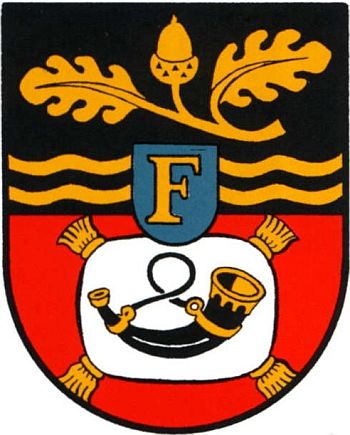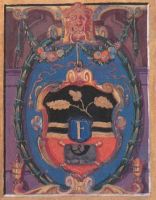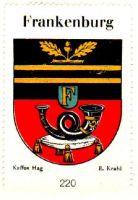Frankenburg am Hausruck: Difference between revisions
Knorrepoes (talk | contribs) m (Text replacement - "===Official blazon=== ===Origin/meaning===" to "{| class="wikitable" |+Official blazon |- |'''German''' | blazon wanted ! |- |'''English''' | |} ") |
Knorrepoes (talk | contribs) No edit summary |
||
| Line 12: | Line 12: | ||
|- | |- | ||
|'''German''' | |'''German''' | ||
| | | Geteilt; blaues Herzschildchen mit goldenem Antiqua-Versalbuchstaben F; oben in Schwarz über goldenem Zwillings-Wellenbalken ein goldener, querliegender Eichenast mit zwei Blättern und einer aufrechten Eichel; unten in Rot ein silberner Polster mit goldenen Quasten an den vier Ecken und darauf liegendem schwarzen, goldverzierten Posthorn mit schwarzer, kreuzweise verschlungener Schnur. | ||
|- | |- | ||
|'''English''' | |'''English''' | ||
| Line 18: | Line 18: | ||
|} | |} | ||
===Origin/meaning=== | |||
The arms were granted on June 11, 1621 at the same time as the town rights, by Emperor Ferdinand II. | The arms were granted on June 11, 1621 at the same time as the town rights, by Emperor Ferdinand II. | ||
The oak leaves on the wavy bars are derived from the arms of the Counts Khevenhüller-Aichelberg, who were Lords of Frankenburg for three centuries until 1810.The pillow and the horn are derived from the arms of Barbara Teufel von Gundersdorf, wife of Christoph Count Khevenhüller, who was Lord of Frankenburg in 1621. The small escutcheon is the initial of the Emperor. | The oak leaves on the wavy bars are derived from the arms of the Counts Khevenhüller-Aichelberg, who were Lords of Frankenburg for three centuries until 1810.The pillow and the horn are derived from the arms of Barbara Teufel von Gundersdorf, wife of Christoph Count Khevenhüller, who was Lord of Frankenburg in 1621. The small escutcheon is the initial of the Emperor. | ||
<gallery widths=250px heights=200px perrow=0> | |||
File:frankenburg1.jpg|alt=Wappen von Frankenburg am Hausruck / Arms of Frankenburg am Hausruck|The arms as shown on the original grant of 1621 | |||
File:Frankenburg.hagat.jpg|alt=Wappen von Frankenburg am Hausruck / Arms of Frankenburg am Hausruck|The arms in the [[Kaffee Hag : Die Wappen der Republik Oesterreich|Coffee Hag album]] +/- 1932 | |||
</gallery> | |||
{{media}} | {{media}} | ||
Revision as of 04:41, 15 August 2022
| Heraldry of the World Wappen der Welt |
| Austrian heraldry portal Österreichische Wappen |
|
FRANKENBURG AM HAUSRUCK
State : Oberösterreich
District : Vöcklabruck
| German | Geteilt; blaues Herzschildchen mit goldenem Antiqua-Versalbuchstaben F; oben in Schwarz über goldenem Zwillings-Wellenbalken ein goldener, querliegender Eichenast mit zwei Blättern und einer aufrechten Eichel; unten in Rot ein silberner Polster mit goldenen Quasten an den vier Ecken und darauf liegendem schwarzen, goldverzierten Posthorn mit schwarzer, kreuzweise verschlungener Schnur. |
| English |
Origin/meaning
The arms were granted on June 11, 1621 at the same time as the town rights, by Emperor Ferdinand II.
The oak leaves on the wavy bars are derived from the arms of the Counts Khevenhüller-Aichelberg, who were Lords of Frankenburg for three centuries until 1810.The pillow and the horn are derived from the arms of Barbara Teufel von Gundersdorf, wife of Christoph Count Khevenhüller, who was Lord of Frankenburg in 1621. The small escutcheon is the initial of the Emperor.
The arms in the Coffee Hag album +/- 1932
Contact and Support
Partners:
Your logo here ?
Contact us
© since 1995, Heraldry of the World, Ralf Hartemink 
Index of the site
Literature : Baumert, H.E. : Oberösterreichische Gemeindewappen, Linz, 1996.















